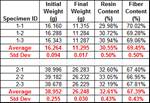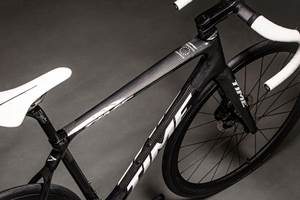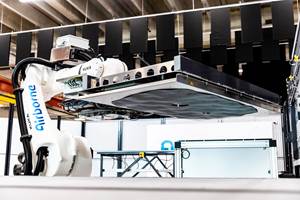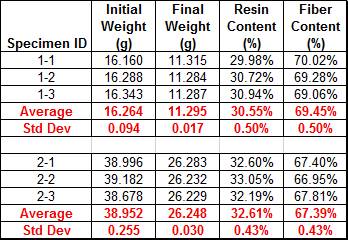Double bagging through three decades
A short history of double-bagging.
Share
Read Next
Double-bagging techniques have a complex history. In the 1980s and 90s, the Naval Air Warfare Center, Aircraft Division in Warminster, Pennsylvania (NAWCADWAR) published papers on a Double Vacuum Debulking (DVD) procedure designed to reduce voids and increase the mechanical properties of wet layup and prepreg repair patches. The process used a rigid enclosure over an inner flexible vacuum bag, to cure 8-ply 5-harness satin AS4 carbon cloth patches impregnated with Hysol EA 9390 and EA 9396 two part wet layup epoxy resins (now supplied by Henkel Corp., Rocky Hill, Conn.). An initial 30- to 60-minute debulk step was followed by application of heat and vacuum in both inner bag and outer enclosure, with the patches cured according to Hysol’s recommended cycle. NAWCADWAR explains that the outer vacuum under the rigid enclosure prevents atmospheric pressure from being applied to the laminate and pinching the edges off, which allows the inner vacuum to remove more volatiles in a shorter time. Then, at a specified point, the vacuum in the rigid enclosure was vented to allow the flexible bag to collapse onto the laminate and apply consolidation pressure. DVD processing was reported to reduce void content in the repair patch laminates from 6 to 7 percent (for single vacuum bag processing) down to 1 to 3 percent. It also improved the Interlaminar Shear Strength of the wet layup patches by 30 percent for EA 9396 and 64 percent for EA 9390.
From CAPRI to DBARTM and DBVI
NASA Langley Research Center (LaRC, Hampton, Va.) has published several technical papers since 2008 describing its development of a Double Vacuum Bag (DVB) process which, like DVD, uses a rigid tool between the outer and inner vacuum bags in order to fabricate phenolic and polyimide composites using out of autoclave (OOA) methods. Phenolics and polyimides are condensation reaction resins, which generate sufficient water and solvent volatiles during cure that single vacuum bag (SVB) OOA processing has failed to produce laminates with acceptably low voids.
LaRC started with the Controlled Atmospheric Pressure Resin Infusion (CAPRI) method patented by the Boeing Co. (Chicago, Ill.), which uses cyclic vacuum debulking and a reduced pressure differential to minimize thickness gradients and also to increase fiber volume. (Infused laminates tend to be thicker at the resin inlet and thinner at the vacuum inlet. See “Double-bag infusion: Thickness and gradient” under “Editor’s Picks,” at right). The driving force in resin infusion is a pressure differential created by reducing pressure in the bag via a vacuum pump while the resin feed tank is exposed to atmospheric pressure, which pushes the resin into the bag through a feed line. The CAPRI method lowers this differential by using an additional vacuum pump to reduce the pressure in the resin feed tank. CAPRI claimed to achieve a 59 percent fiber volume using seven vacuum debulk compaction cycles and a resin feed pressure of 20 in. Hg (0.67 atm) versus full atmospheric pressure, which is nominally 1 atm (29.92 in. Hg). (Atmospheric pressure decreases with altitude from sea level and varies with weather conditions.)
Initially, LaRC used an inner bag over 10 layers of IM7-6K carbon fiber 5-harness satin fabric from Hexcel (Dublin, Calif.), five layers of aluminum screen as flow media, Release Ease fabric from Airtech (Huntington Beach, Calif.), a breather material and an outer bag included only as redundancy in case of a leak in the inner bag. In its quest to reduce voids, LaRC eventually controlled pressure on the outer and inner bags independently, using a perforated rigid tool in between. It also incorporated a vacuum fluctuation or “bumping” on the inner bag. After infusion of LaRC’s PETI-330 polyimide resin was completed at elevated temperature (260˚C/500˚F), vacuum on the outer bag was removed and vacuum on the inner bag was reduced from 101.6 kPa (≈30 in. Hg) to 50.8 kPa (≈15 in. Hg) and then returned to full vacuum. This “bumping” was repeated twice, after which vacuum on the outer bag was returned to 30 in. Hg and the normal cure cycle completed. Other process variations included an additional layer of breather cloth placed above the aluminum screen flow media and heat treating the carbon fiber reinforcements to remove any potential residue from manufacture. Void content dropped to as low as 2.3 percent with a 55 percent fiber volume and 2.5 percent with a 57 percent fiber volume.
San Diego Composites (San Diego, Calif.) presented a technical paper at the SME Composites Manufacturing 2010 conference in April this year, describing its Double Bag Assisted Resin Transfer Molding (DBARTM) method, which reduced void content in PETI-330 polyimide stitched fabric laminates from 5 percent to less than 2 percent, which NASA considers on par with autoclave processing. PETI-330 resin is now available from UBE Aerospace (Ottawa, Ontario, Canada) under license from NASA. San Diego Composites will scale up DBARTM to produce large panels, complex geometries and full-scale integrally stiffened structures in a Phase II program.
Aimed at improving the void content and mechanical properties of epoxy OOA composites, Boeing has developed a double bag process variant, which they term double bag vacuum infusion (DBVI). It uses two flexible vacuum bags separated by a breather, with both bags either connected to the same vacuum source, or if discrete, then vacuum on the inner bag must equal or exceed that within the chamber between the two bags. Once the laminate is infused within the inner bag, resin feed and vacuum lines are clamped off simultaneously, and full vacuum is maintained in the outer bag throughout the cure. Boeing states that the resulting laminates are comparable in quality to those made using autoclave-cured prepregs and that this process can produce composites with fiber volumes 5 to 10 percent higher than it has achieved using the patented SCRIMP and CAPRI single-bag infusion technologies.
Related Content
Corebon induction heating
This sidebar to CW’s August 2024 feature article reviews this technology for more efficient composites manufacturing and why it aligns with Koridion active core molding.
Read MoreTime Bicycles to modernize composite bicycle manufacturing
With the aid of KraussMaffei, Clemson University and SC Fraunhofer USA Alliance, Time anticipates a transition to HP-RTM for more efficient carbon fiber bike frame manufacture, plus a new facility in South Carolina.
Read MoreModular, robotic cells enable high-rate RTM using any material format
Airborne’s automated ply placement systems at Airbus, GKN Aerospace and Teijin Automotive Technologies aim to maximize flexibility and intelligent automation.
Read MoreAll-recycled, needle-punched nonwoven CFRP slashes carbon footprint of Formula 2 seat
Dallara and Tenowo collaborate to produce a race-ready Formula 2 seat using recycled carbon fiber, reducing CO2 emissions by 97.5% compared to virgin materials.
Read More




















